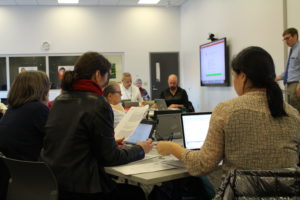Over the past five years, I’ve worked with many schools and districts across the United States interested in making data matter for setting goals and improving outcomes. The educators and leaders I’ve worked with who were most successful in using their data to drive improvement were not only skilled in making sense of the results, but also intentional in how they engaged and communicated with their community before collecting data. Making sure that their community knew why and how the data was being collected, what different results would suggest, and how best to use the data to take action set them up for success, and helped them leverage their data to improve teaching and learning.
No matter what kind of data you’re planning to collect and use, I recommend focusing on five general principles to help you move from reflection to meaningful action. Building consciously on these principles over the course of the year will ensure that by the time you, your fellow leaders, and your teachers receive data, they’ll be ready to use move intentionally from reflecting on results to using data to act.
"Ultimately, collecting data is part of a larger process of building trust, transparency, and shared vision around success and improvement."
1. Build Investment
Your community needs to know why this data matters and how it will improve student outcomes. Cultivating a sense of excitement and investment in your community will help you collect higher-quality responses from more people. Some of our most successful partners have come up with large-scale outreach plans that have resulted in dramatically raising their response rates, while others have worked closely with planning committees in their school or district to help educators understand why the data being collected will be valuable. Well before collecting data, consider gathering a focus group of other school leaders and teachers across your community to identify shared goals and how to communicate a shared purpose.
2. Clarify Outcomes
Your community needs to know why you’re collecting data, and how you intend to use it. Being transparent about your goals for this data, and how your community can help you achieve them, will help the families, students, and faculty and staff in your school or district rally around giving feedback. It’s also important for your school community to know and understand whether the data you collect is going to be used for evaluation purposes.
I’ve found that the schools and districts that have a clear vision of success for their data, and who do a good job communicating that vision, collect data more smoothly and create a culture of trust among educators and other community stakeholders.
3. Protect Time
Your community needs to know when they will have time to make meaning out of their results. Because there are many demands on teacher and school administrator time in schools and districts, protecting time to look at results will guarantee that your educators and fellow leaders will have an opportunity to start using their data to reflect and take action. Many of our most successful partners have scheduled professional development sessions or administrator data retreats well before they even collected data.
As you plan how you want to use your data, think about what your professional development and academic calendars look like. Should you be holding time for a professional learning session with your teachers and staff? Have you asked teacher teams and professional learning communities to find a time to engage with the data they’ll receive? Being proactive about setting time aside means that you will make sure that teachers are equipped to dig into their data and take action from it.
4. Build Data Literacy
Your community needs to know how to interpret their results. In order for faculty and staff in schools and districts to understand the data that they’ll receive, it’s crucial to do some training with them about how the data can be accessed, how it will look, and the tools and protocols they can use to engage with it. To help them make sense of their results in context, it can be helpful to provide faculty and staff with comparisons, benchmarks, and dashboards to facilitate digging into the data.
 Looking at data in a group setting.
Looking at data in a group setting.Many of our partners have chosen to look at data in group settings, which has allowed them to create a space for colleagues to ask questions, share learnings, and come up with best practices. Using a structured process to look at data together helps cultivate data literacy in advance of receiving actual results.
5. Affect Student Outcomes
Your community needs to know how to move from reflection to action. So that your faculty and staff are ready to take next steps from their data, confirm that they know how to select high-leverage areas for improvement based on the feedback they’ve received. Make sure that educators in your community can come up with an action plan, determine how they’ll track progress on goals, and know when they’re going to reconvene to reflect and iterate on what they’ve done.
Many of our most successful partners have encouraged teachers to use their end-of-year check-in’s with administrators as an opportunity to establish and reflect on those data-driven focus areas. Increasingly, I’m seeing partners use their feedback data to inform their strategic planning, or to determine whether they’re meeting the larger goals they set for themselves and their community.
Ultimately, collecting data is part of a larger process of building trust, transparency, and shared vision around success and improvement. Following these principles will help you get a tremendous amount out of the feedback you receive from the stakeholders in your community-- and enable you to use data to drive meaningful school- and district-wide change.
Sejin Mong is Special Engagements Manager at Panorama Education and a Certified Data Wise Coach. This blog post was first published by EdTech Digest.




.jpg)

